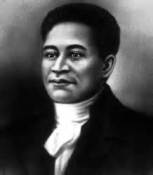There are so many misrepresentations, stories rewritten, changed, or just simply true facts unknown when it comes to historical significance regarding African American’s and American history. In fact, it was not until the 20th century that any of our history was even recorded. Another fact: most slaves or African Americans prior to the 20th century never received a certificate of birth. This brings me to the subject of the first Negro killed in the Revolutionary War for America’s freedom.
No much is known about Crispus Attucks and all we do know was produced by those who had a vested interest in using his name or color for their cause. Attucks was born into slavery around 1723, in Framingham, Massachusetts. He was the son of a slave father shipped to America from Africa and a Natick Indian mother. This is an important piece of evidence regarding his place in history. We are supposed to believe that a slave was on the forefront of the movement to free the nation from British rule.
Therefore, what is claimed or taught though history is that Attucks was supposed to be the first to fall during what’s called the Boston Massacre on March 5, 1770. Personally, I think this claim was to disguise the fact that the new land was a major purveyor of slavery where many states sanctioned such by law or what law there was.
What has been pieced together paints a picture of a young man who showed an early skill for buying and trading goods. He seemed unafraid of the consequences for escaping the bonds of slavery. Historians have, in fact, pinpointed Attucks as the focus of an advertisement in the 1750 edition of the Boston Gazette in which a white landowner offered to pay 10 pounds for the return of a young runaway slave.
“Ran away from his Master William Brown from Framingham, on the 30th of Sept. last,” the advertisement read. “A Mulatto Fellow, about 27 Years of age, named Crispas, 6 Feet two Inches high, short curl’d Hair, his Knees nearer together than common: had on a light colour’d Bearskin Coat.”
Attucks, however, managed to escape for good, spending the next two decades on trading ships and whaling vessels coming in and out of Boston. Attucks also found work as a ropemaker. As British control over the colonies tightened, tensions escalated between the colonists and British soldiers. Attucks was one of those directly affected by the worsening situation. Seamen like Attucks constantly lived with the threat they could be forced into the British navy, while back on land, British soldiers regularly took part-time work away from colonists.
On March 5, 1770, a Friday, a fight erupted between a group of Boston ropemakers and three British soldiers. Tensions were ratcheted up further three nights later when a British soldier looking for work entered a Boston pub, only to be greeted by a contingent of furious sailors, one of whom was Attucks.
The details regarding what followed have always been the source of debate, but that evening a group of Bostonians approached a guard in front of the customs house and started taunting him. The situation quickly escalated. When a contingent of British redcoats came to the defense of their fellow soldier, more angry Bostonians joined the fracas, throwing snowballs and other items at the soldiers.
Attucks was one of those in the middle of the fight, and when the British opened fire he was the first of five men killed, which is why he is claimed to be the first casualty of the American Revolution. However, as a runaway slave it is highly doubtful that Attucks would challenge the British authorities for a cause that he had no stake in.
In fact, this episode was nothing more than the actions of an unruly mob, and there was no war at the time. John Adams the second president of the new country represented the British Soldiers in court who fired the shots charged, though debate has raged over how involved he was in the fight. One account claims he was simply “leaning on a stick” when the gunshots erupted.”
Regardless, Attucks became a martyr and post-harmoniously received a statue as a hero. His body was transported to Faneuil Hall, where he and the others killed in the attack lay in state. City leaders even waived the laws around black burials and permitted Attucks to be buried with the others at the Park Street cemetery.
In the years since his death, Attucks’s legacy has continued to endure, first with the American colonists eager to break from British rule, and later among 19th century abolitionists and 20th century civil rights activists. Dr. Martin Luther King, Jr. in his 1964 book, Why We Can’t Wait, lauded Attucks for his moral courage and his defining role in American history.









Leave a comment